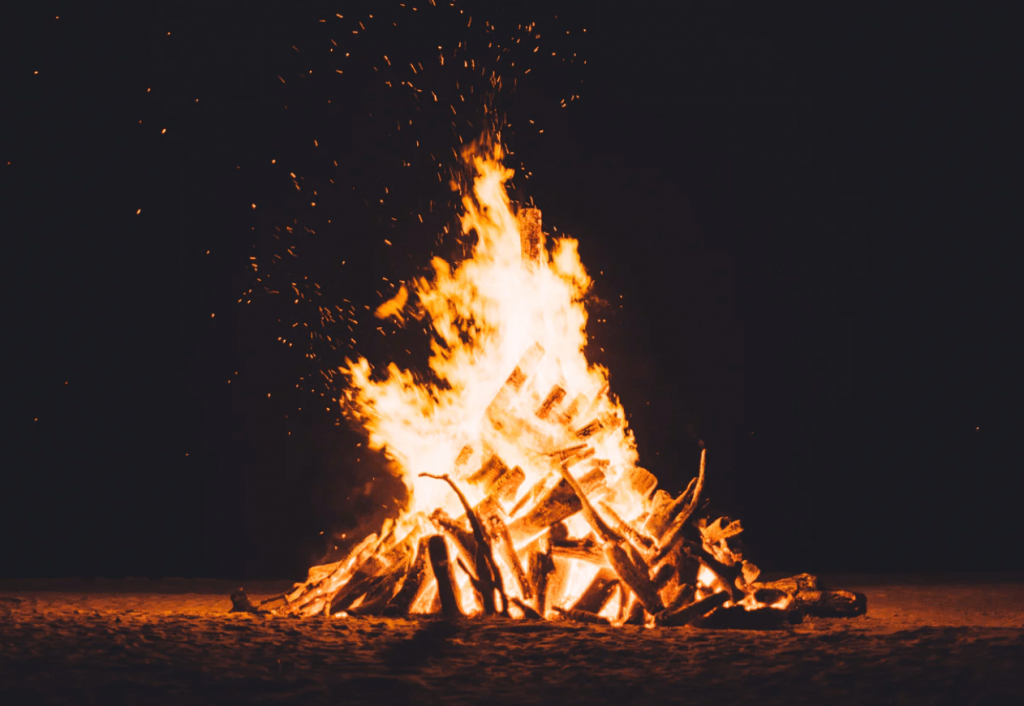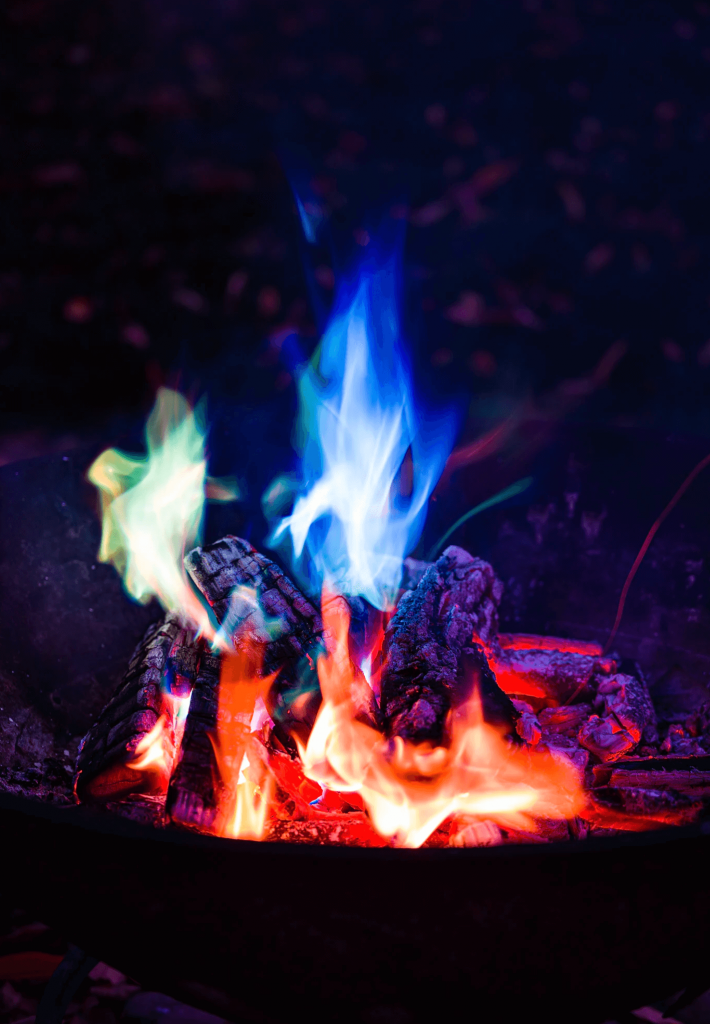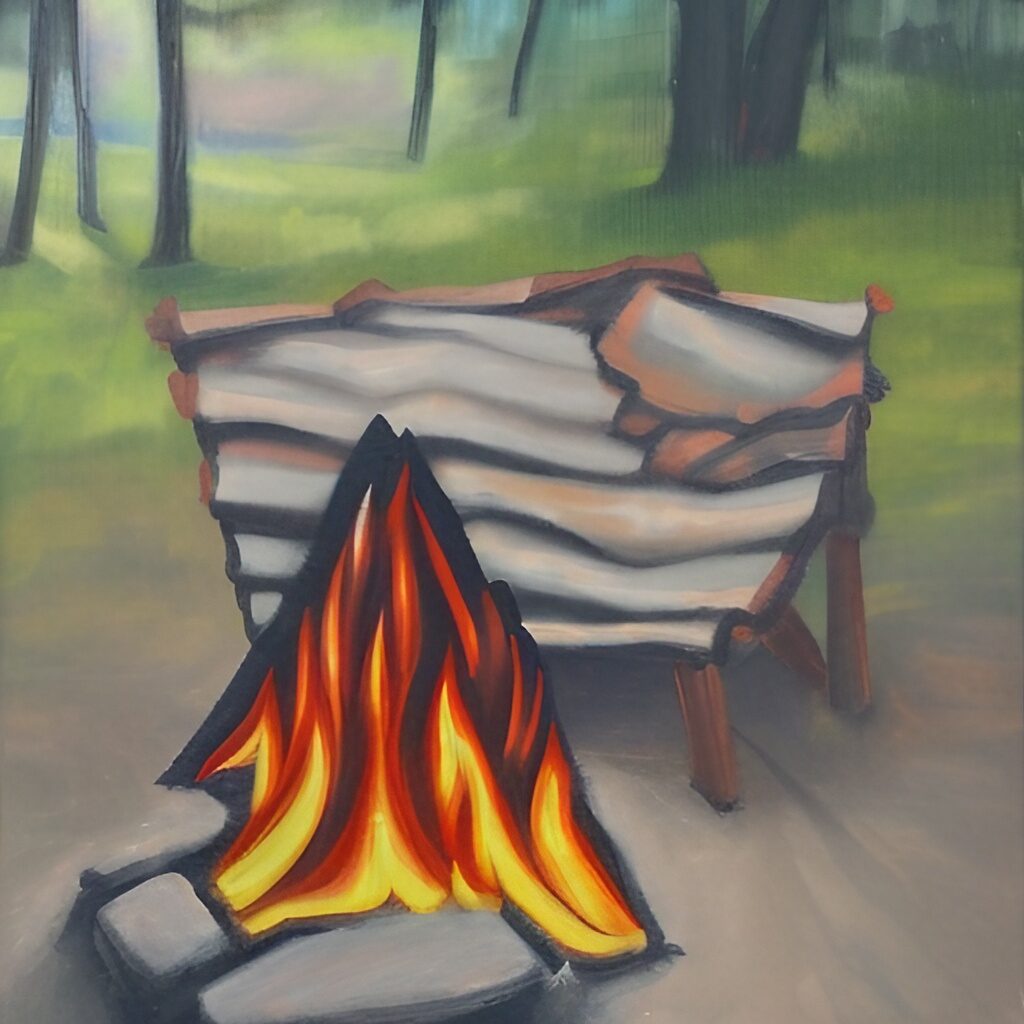
If you ask campers what they consider when setting up base, very few are likely to say campfire temperature. However, understanding how to measure the heat from your campfire makes it easier to cook different meats and helps you avoid accidentally melting your cutlery!
After years spent cultivating campfires in a variety of different terrains, campfire temperature is something I have had to consider a lot. This experience, combined with hours of extensive research, means I can confidently answer when asked “how hot is a campfire?”
On average, a well-stacked and medium-sized campfire will burn internally at around 900°F (482°C). This is not a one size fits all rule though. A bonfire can burn in excess of a whopping 2,000°F (1093°C).
However, the temperature of a campfire can be difficult to measure accurately, and the heat produced by a campfire can be affected by a number of factors, such as wind, humidity, oxygen flow, type of wood, and the amount and type of fuel being burned. It’s important to follow safety guidelines when building and maintaining a campfire to avoid accidental burns and other hazards.
How can I tell how hot my campfire is?
Although some recommend estimating the temperature of your campfire by holding your hand over it, this is not something I’d advise doing. You don’t want to get burnt! Luckily, you can tell a lot about how hot your campfire is, just by looking at the color of the flames.

Flame colors
If your campfire is full of varying colors, it means that the temperature across the fire is uneven. According to Sciencing, this is what each flame color represents in terms of temperature:
White: The closest part of the flame to the wood is likely to be white. This is often, but not always, the hottest part of the fire, as it is the closest to the fuel source. The further you move away from the fuel source, the less heat there will be.
Blue: Sometimes, you may see a blue/white flame. The addition of the blue color means that the flame is even hotter than when it is purely white. Blue flames tend to appear when the temperature reaches between 2,600°F and 3,000°F (1,427°C-1,649°C). It burns the hottest out of all the flame colors because it is receiving more oxygen.
Deep red: This is one of the most common flame colors that you will see in a campfire. Fires that are deep red in color are likely to be around 1,100-1,650°F (593°C-899°C).
Orange/yellow: Orange or yellow flames demonstrate the fire is burning between 1,800-2,500°F (982°C-1,371°C) in this area.
What Affects Campfire Heat?
The temperature of your campfire will be impacted by three factors:
Fuel
It will come as little surprise that different types of wood will burn differently. The following types of wood are all highly rated for building campfires:
- Hickory: A dense type of wood that retains little moisture. It can be tough to chop but burns hot. It is perfect for grilling and smoking meat or fish.
- Oak: This slow-burning hardwood gives off little in the way of sparks while still putting out a lot of heat.
- Ash: A great lightweight firewood that can be found in many environments. It burns easily and doesn’t emit much smoke. Ash also holds minimal moisture and splits with little effort.
- Cedar: Although this kind of wood doesn’t create flames as large as some of the other firewood on this list, it packs a punch when it comes to heat. It is ideal for keeping your campsite warm and cozy.
The dryness of the fuel also impacts the heat of your fire. Dry wood will burn considerably better than damp wood and therefore, it will reach hotter temperatures. If some of your wood is damper, put it to the outside of your fire. Once the fire gets going, it will dry out from the heat.
Don’t forget the importance of both kindling and tinder too. You’ll need both of these to start your fire and create a strong foundation for the bigger pieces of wood you’ll add later.
Size
The size of your fire will also affect how hot your campfire gets. When camping, you should always aim for a small to medium-sized campfire to keep the blaze manageable. A fire of this size will be more than suitable for keeping you warm and cooking food.
The size of your firewood also comes into play. Opt for firewood around 16 inches long and around 3-6 inches wide. This is ideal as it will burn at a good pace, maximizing heat retention.
Oxygen flow
Good fires need a steady supply of oxygen to ensure they continue to burn hot. Campfires in a metal fire pit will not generate as much heat as open fires that benefit from a gentle breeze.
However, you should never try to light a campfire in strong winds as you risk causing damage to both yourself and the environment.
To ensure that you allow a constant stream of oxygen to your fire, layer the tinder and then create a teepee structure using your kindling over the top. Once you’ve finished making this structure, you’ll layer over some of your smaller firewood in the same formation again.
As the fire grows, you can then add larger pieces of wood to the teepee structure. This will allow air into the fire, feeding the flames and keeping it hot.
We have a detailed article on how to build a campfire if you want more tips and advice.
Top tip: Make sure you are aware of wind direction. A strong breeze can easily increase the size and temperature of your fire.
Campfire Cooking Temperatures
If you are finishing off a beautiful day in the wilderness with a hearty meal, you’ll want to know how to cook on a campfire.
You should cook above the flames, in the area known as the thermal plume region. In this area, the temperature will be around 600°F (315°C), which is a good average temperature for campfire cooking.
Regulate Open Fire Temperatures
Cooking on a campfire is not like cooking in your kitchen! You’ll need to work with the fire and the wind if you are going to successfully increase or reduce the heat of the fire.
First comes the easy part. To turn down the heat, simply raise your cookpot higher over the fire. You can then move up the grilling platform so that you can sit the cookpot further from the flames.
Increasing the campsite fire temperature is a little more tricky. You’ll need to add more wood fuel to the fire but don’t fall into the trap of loading it at once. This makes it more likely that you will burn your food.
Start with small pieces of wood and add more as needed. If you add too much, you can raise your cookpot higher until the flames die down a little.
Cooking Temperatures of Meat
Although many campers love the simplicity and ease of a dehydrated meal, others prefer to replenish calories with a freshly cooked meat feast. If you are somebody who wants to cook meat on the fire, you’ll need to pay attention to campfire temperature.
Even though it is possible to estimate how long different cuts of meat will take to cook over a campfire, this varies depending on how hot the campfire is. Campers who want to cook over the fire are advised to bring a meat thermometer to check that food is up to temperature.
Experts recommend that food is heated to between 140-165°F (60-74°C) to kill any pathogens. It is not advisable to try and gauge whether food is cooked by looking at it as it isn’t always possible to tell. Let’s be honest, the last place you want to have an upset tummy is in the wilderness, so it is better to be safe!
Listed below are some of the most popular meats, along with the desired internal temperatures that you need to look for if you are cooking them over a campfire.
- Steak (rare) 118ºF (48°C)
- Steak (medium) 136ºF, (58°C)
- Steak (well done) 154ºF (68°C)
- Lamb leg (medium-rare) 135ºF (57°C)
- Pork tenderloin 145ºF (63°C)
- Chicken breast 165ºF (74°C)
Metal Melting Points
Knowing the temperature of a campfire can be very helpful when buying camping cooking utensils. After all, you don’t want your expensive kit to melt!
To help you decide which utensils and cookware best suit you, we’ve given you an idea of metal melting points below.
- Titanium: 3,034°F (1,667°C)
- Aluminum: 1,220°F (660°C)
- Stainless steel: 2,750°F (1,510°C)
- Cast iron: 2,060°F (1,126°C)
It’s not just cans that are made from aluminum! Be aware that some camping cooking utensils are also made from this material and can melt in very hot fires. If you are looking for longevity and a product that will withstand any accidents, you are best to opt for stainless steel or titanium.
In the Walk Highlands forum, one camper had this to say: “I use titanium pots. I’ve had one of them over 10 years and apart from it being a bit discolored due to different cookers, it works as good as the first day [I bought it]!”

How Hot Is a Campfire? Conclusion
Now you know the answer when somebody next asks you “how hot is a campfire?” Although the average is around 900°F (482°C), other factors will influence this, including the size of the fire, the type of fuel, and the oxygen supply.
By understanding campfire temperatures, you can make informed decisions when purchasing cooking utensils and invest in products that will stand the test of time. Now all that is left to do is deciding what delicious camp meals you are going to be cooking on your open fire.
How Hot Is a Campfire? Frequently Asked Questions
What is the best way to sustainably increase a campfire’s temperature fast?
Sustainably increasing a campfire’s temperature quickly can be challenging as it requires a steady supply of fuel and oxygen. Here are some tips to help increase the temperature sustainably:
- Use dry and seasoned wood: Dry and seasoned wood burns more efficiently, producing more heat with less smoke.
- Add small pieces of wood: Smaller pieces of wood burn faster and hotter, providing a quick boost of heat.
- Add kindling: Kindling can help get the fire going and provide a quick boost of heat.
- Use a fire starter: Fire starters can help ignite the fire quickly and get it burning hot.
- Increase airflow: Increasing airflow by blowing on the fire or using a bellows can help stoke the flames and increase the temperature.
It’s important to note that it’s best to start with a small fire and add fuel gradually to prevent the fire from getting out of control. Also, it’s important to follow local fire regulations and guidelines to ensure safety and protect the environment.
What is the best way to sustainably decrease a campfire’s temperature fast?
The best way to sustainably decrease a campfire’s temperature is to gradually reduce the amount of fuel being added to the fire. This can be achieved by allowing the fire to burn down naturally or by using a shovel or other tool to move the hot coals to the side of the fire pit where they can cool down. It is important to never pour water on a fire to extinguish it, as this can cause a sudden release of steam and create a dangerous situation. Instead, it is recommended to use water or sand to gradually smother the fire and allow it to cool down over time.
What is the ideal campfire temperature for comfort?
The ideal temperature for a campfire depends on personal preference and the specific use of the fire. Generally, for comfort and relaxing around the fire, a temperature of around 400-600°F (200-300°C) is ideal. However, if you are cooking over the fire, the temperature will vary depending on the specific recipe and cooking method.














